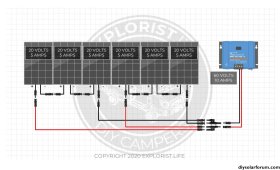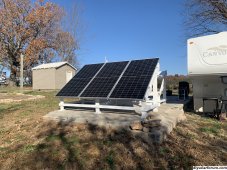A lot of building codes require the wire to have circuit protection 1.56 times ISC. 10 AWG solar has a maximum of 30 amp SP if ran outside. This makes the maximum panel IEC 9.61A when paralleled (19.22 total). Panels above 350 watts (sometimes less sometimes more depending on number of cells and the resulting voltage) often exceed 9.61 amps. This restriction doesn't apply to 8 awg. You 55 amps at 75C or 17.62 ISC per panel. With a 50 amp breaker you can have 16.02 ISC panels.So string #1 had 3 panels, string #2 had 3 panels.
Is there any way you could convert string #2 to a 2s2p with a y junction at the panels, same 10awg back to your SCC, then where string 1 and 2 combine up that 6 foot run to #8 or something larger?
2s2p is perfectly fine for 10awg.
You are using an out of date browser. It may not display this or other websites correctly.
You should upgrade or use an alternative browser.
You should upgrade or use an alternative browser.
Need to Reduce solar voltage!!
- Thread starter vashkoproimage
- Start date
zanydroid
Solar Wizard
I’m only aware of MidNite HyperVoc feature that guarantees a cushion above its max VOC cutoff.I think it’s a misconception that a ssc will start smoking if supplied over-voltage. My controller personally will not supply any charge with overvoltage. It just cuts pv input off when over 145v. Can’t say this about all scc are this way.
For any hypothetical SCC, how would the controller protect itself if say the input FETs are rated to 150V? Or FET based BMS. It’s somewhat counterintuitive to analyze the voltage across a FET in these kinds of conditions.
Any SSR automatic disconnect would potentially need to be rated to the higher voltage as well as able to carry the current density… in which case maybe those FETs inside should have been used as the power FETs in the first place
Last edited:
vashkoproimage
New Member
- Joined
- Apr 6, 2022
- Messages
- 57
zanydroid
Solar Wizard
Where is the 30A limit listed in code? I have been confused about 30 vs 35 because there is no need for OCPD, and often #10 is allowed to carry 35A circuits on 75C terminations in cases where OCPD over 30A is allowedA lot of building codes require the wire to have circuit protection 1.56 times ISC. 10 AWG solar has a maximum of 30 amp SP if ran outside. This makes the maximum panel IEC 9.61A when paralleled (19.22 total). Panels above 350 watts (sometimes less sometimes more depending on number of cells and the resulting voltage) often exceed 9.61 amps. This restriction doesn't apply to 8 awg. You 55 amps at 75C or 17.62 ISC per panel. With a 50 amp breaker you can have 16.02 ISC panels.
I would say the majority of new 400W panels sold today are in 12A+ range due to the prevalence of 54 cell in the inventory. Which is why I’ve suggested #8 for hauling back from an array if there’s a decent chance it might be expanded…
Bluedog225
Texas
- Joined
- Nov 18, 2019
- Messages
- 3,225
Why not run additional wire for the higher amps?
timselectric
If I can do it, you can do it.
- Joined
- Feb 5, 2022
- Messages
- 19,580
It hasn't yet. But, it's just a matter of time before your luck runs out.I think it’s a misconception that a ssc will start smoking if supplied over-voltage. My controller personally will not supply any charge with overvoltage. It just cuts pv input off when over 145v. Can’t say this about all scc are this way.
vashkoproimage
New Member
- Joined
- Apr 6, 2022
- Messages
- 57
Lol Did you even read the post? I already disconnected 1 panel of each array. Total of 4 panels running now in safe zone. Trying to find a solution to lower voltage down 5-10 volts for previous setup.It hasn't yet. But, it's just a matter of time before your luck runs out.
How much current would be pushing in a 2s2p set to his y combiners?A lot of building codes require the wire to have circuit protection 1.56 times ISC. 10 AWG solar has a maximum of 30 amp SP if ran outside. This makes the maximum panel IEC 9.61A when paralleled (19.22 total). Panels above 350 watts (sometimes less sometimes more depending on number of cells and the resulting voltage) often exceed 9.61 amps. This restriction doesn't apply to 8 awg. You 55 amps at 75C or 17.62 ISC per panel. With a 50 amp breaker you can have 16.02 ISC panels.
2x isc, that’s still well under 10awg of the 100‘ or 165’ run back to his SCC.
And those wye connectors are near the SCC right?This is the setup I had issue with over voltage. 3s2p
timselectric
If I can do it, you can do it.
- Joined
- Feb 5, 2022
- Messages
- 19,580
That was an earlier post. I was replying to the last post.Lol Did you even read the post? I already disconnected 1 panel of each array.
But you said that it wasn't going to be enough production.Total of 4 panels running now in safe zone.
You will be much better off spending money on the right equipment. Rather than a bandaid, for the current mistake.Trying to find a solution to lower voltage down 5-10 volts for previous setup.
Hedges
I See Electromagnetic Fields!
- Joined
- Mar 28, 2020
- Messages
- 21,398
Lol Did you even read the post? I already disconnected 1 panel of each array. Total of 4 panels running now in safe zone. Trying to find a solution to lower voltage down 5-10 volts for previous setup.
Open junction box and move PV wire connection over one diode-bypassed section. That is, leave off 1/3 of the cells in one panel.
But consider 2s3p, with multiple orientations. That may fit within specs and physics, if not code, and make use of all cells.
Is that before or after you derate the wire? Anyway, it's not particularly unsafe and with that long of run wire is expensive. That's why you're getting the voltage dropped though. 10 AWG is your standard size/smallest typically used on houses solar wire. 535 watt panels are some big panels.
He has two arrays currently 3s and 3s, each with a 10awg decently long “home run” to within 6 feet of the SCC, not sure if he can rig up one array to hold 4Open junction box and move PV wire connection over one diode-bypassed section. That is, leave off 1/3 of the cells in one panel.
But consider 2s3p, with multiple orientations. That may fit within specs and physics, if not code, and make use of all cells.
panels.
vashkoproimage
New Member
- Joined
- Apr 6, 2022
- Messages
- 57
So does it make sense to buy a 20kw solar inverter for my future setup and use it for these 6 panels? That’s how much panels I have when house is built. Why run a new 20kw inverter when all I need 6 panels while building house. Does not make sense until larger setup is needed. This is just a temporary setup and will be torn down once new one is up. My current 6kw works just fine for what I’m using it. All I’m trying to do it connect as much as can for temporary setup. If I have extra equipment laying around why not just use what I have if temporary? Make sense to you?That was an earlier post. I was replying to the last post.
But you said that it wasn't going to be enough production.
You will be much better off spending money on the right equipment. Rather than a bandaid, for the current mistake.
vashkoproimage
New Member
- Joined
- Apr 6, 2022
- Messages
- 57
He has two arrays currently 3s and 3s, each with a 10awg decently long “home run” to within 6 feet of the SCC, not sure if he can rig up one array to hold 4
panels.
Attachments
vashkoproimage
New Member
- Joined
- Apr 6, 2022
- Messages
- 57
Yes. 6 feet from controller.And those wye connectors are near the SCC right?
timselectric
If I can do it, you can do it.
- Joined
- Feb 5, 2022
- Messages
- 19,580
If you just need a temporary solution.So does it make sense to buy a 20kw solar inverter for my future setup and use it for these 6 panels? That’s how much panels I have when house is built. Why run a new 20kw inverter when all I need 6 panels while building house. Does not make sense until larger setup is needed. This is just a temporary setup and will be torn down once new one is up. My current 6kw works just fine for what I’m using it. All I’m trying to do it connect as much as can for temporary setup. If I have extra equipment laying around why not just use what I have if temporary? Make sense to you?
Then hedges gave it to you.
Do this to one panel in each 3s2p string.Open junction box and move PV wire connection over one diode-bypassed section. That is, leave off 1/3 of the cells in one panel.
vashkoproimage
New Member
- Joined
- Apr 6, 2022
- Messages
- 57
Leaving 1/3 cell might actually work.? never took off the junction box and messed with it. Any tips on this?Open junction box and move PV wire connection over one diode-bypassed section. That is, leave off 1/3 of the cells in one panel.
But consider 2s3p, with multiple orientations. That may fit within specs and physics, if not code, and make use of all cells.
Hedges
I See Electromagnetic Fields!
- Joined
- Mar 28, 2020
- Messages
- 21,398
You can use it until it dies.
Our recommendation is to ensure voltage, even in cold, does not exceed SCC or inverter spec.
Designs vary. Some have 3 small boxes. Others one with a screwed on lid, others glued.
Disconnect from other panels in the string before messing with it! (shut off to stop current before disconnecting.)
If you can get in there, either move the PV wire or just short out any one bypass diode.
Our recommendation is to ensure voltage, even in cold, does not exceed SCC or inverter spec.
Leaving 1/3 cell might actually work.? never took off the junction box and messed with it. Any tips on this?
Designs vary. Some have 3 small boxes. Others one with a screwed on lid, others glued.
Disconnect from other panels in the string before messing with it! (shut off to stop current before disconnecting.)
If you can get in there, either move the PV wire or just short out any one bypass diode.
pollenface
Solar Addict
I’m not running the entire system on only (1) set of 10 gauge wire bro. I’m running 2 sets of wires (3 panels) 160ft and second set of wire 100ft distance. And that’s total lengths including positive and negative runs. More than sufficient for 2s3p.
I can’t do 3s2p. The distance is too far and the voltage will be too low for my 10 gauge wire. I need the voltage to be on the higher side to keep amps down to get away from running long distance. That’s why I went with 2s3p. If I was to running 3s2p then I will have to run 8-6 gauge wire to be under the 3 percent voltage drop.
So are you doing 2s3p now? Problem solved?
Last edited:
Similar threads
- Replies
- 2
- Views
- 304
- Replies
- 4
- Views
- 249




